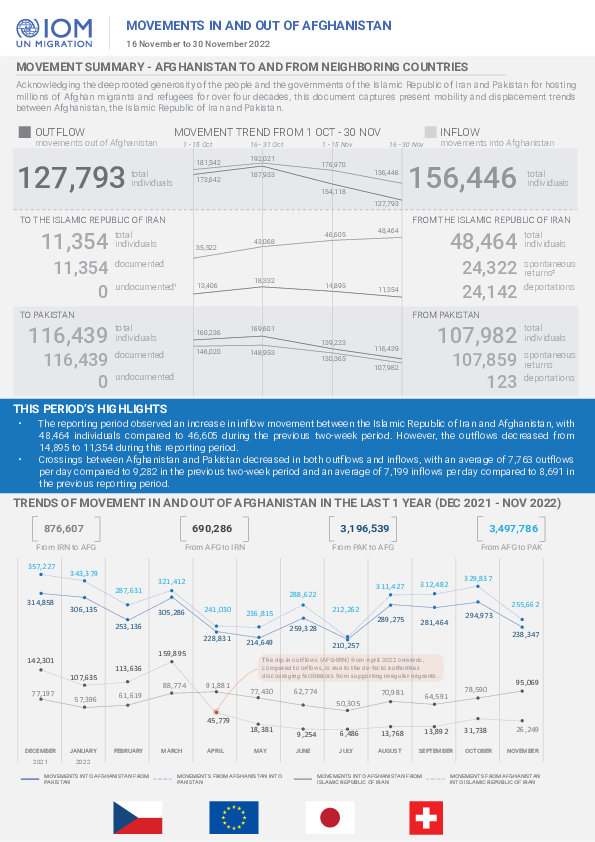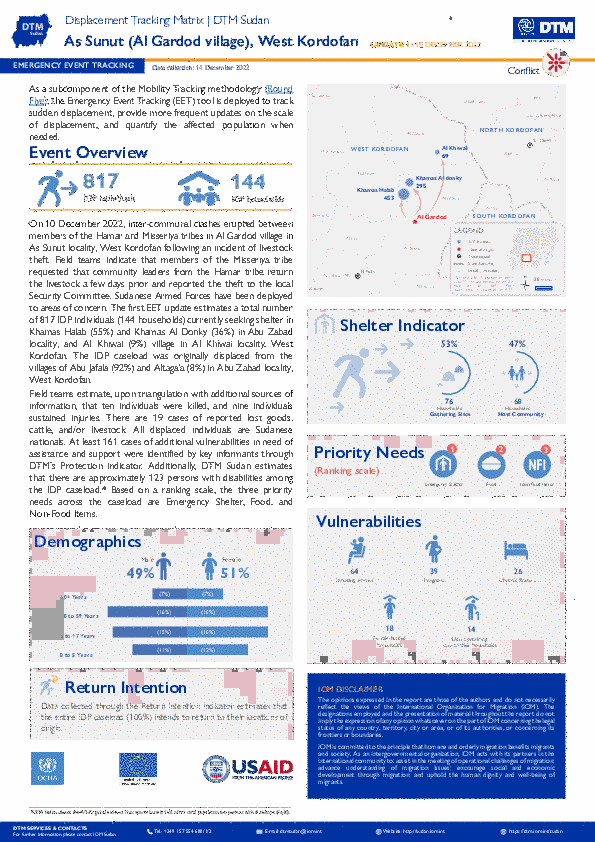-
Countries
-
Data and Analysis
-
Special Focus
-
Crisis Responses
Contact
DTM Yemen, DTMYemen@iom.int
Location
Yemen
Activity
- Mobility Tracking
- Baseline Assessment
Period Covered
Oct 01 2022 -Nov 30 2022
This summary presents the findings of the first round of Area Assessment (Mobility Tracking) undertaken by IOM’s Displacement Tracking Matrix to establish a new baseline on the number of Internally Displaced Persons (IDPs), IDP returnees and migrants in Yemen. Findings are currently limited to the country’s south controlled by the internationally recognized government (IRG).
Data was collected by 153 enumerators through an extensive network of Key Informants (KIs) within the operational area. In the Yemen context, the practice for field teams is to select KI representatives of both the host and target communities while adhering to the humanitarian principles of humanity, neutrality, impartiality and operational independence. This ensures that the selected KIs are the most relevant and appropriate individuals to ensure the successful implementation of the exercise. This round 3,633 KIs were interviewed to collect the data, of whom seven per cent or 270 were female and 93 per cent or 3,363 were male.
Among the main outputs of the Sub-Area Assessment, is a list of locations where IDPs, returnees and / or migrants are present that can be used to inform more detailed assessments at the location level, including the annual Multi-Cluster Location Assessment
(MCLA). DTM field staff, along with KIs, use the Sub-Area Assessment tool to capture locations, which are matched to the identified locations in the OCHA Common Operational Dataset (P-Codes).
Using a standardized and structured approach to the selection of KIs is a key step to ensuring that data collected in the Sub-Area Assessment is comprehensive and comparable across the different teams.
The Sub-Area Assessment tool is used to verify and update the baseline information in regular intervals (rounds). Deployed DTM staff, called enumerators, are in regular communication with their KI network throughout each month and work continuously to maintain and expand this network to further triangulate the displacement statistics collected. The forms and definitions used can be accessed here.
Please note that findings represent the results of a pilot round in this new format. Findings for Aden Governorate are not supported by Yemen’s Central Statistical Organization (CSO) and the Executive Unit for IDP Camps Management (ExU) for this round but will be further verified in the subsequent round of the Area Assessment in 2023. The ExU maintains that the current number of IDPs living in Aden stands at 145,857 individuals.
Population Groups
Survey Methodology
Unit of Analysis Or Observation
Type of Survey or Assessment
Keywords
Geographical Scope
Administrative boundaries with available data
The current dataset covers the following administrative boundaries

Contact
DTM Mali, DTMMali@iom.int
Language
French
Location
Mali
Period Covered
Jul 01 2022
Sep 30 2022
Activity
- Survey
- Flow Monitoring Survey
- Flow Monitoring
Ce rapport met en exergue les principaux résultats issus de l’enregistrement de flux de migrants et des enquêtes individuelles effectués par la DTM auprès des migrants transitant aux différents points de suivi de flux (FMP) du Mali au cours du troisième trimestre de l’année 2022.
Les différents résultats témoignent du fait que le Mali soit l’une des principales routes empruntées par les migrants en Afrique de l’Ouest. En effet, la diversité des nationalités observées (23 nationalités), des routes empruntées, des pays de provenance et de destination, démontrent la place prépondérante qu’occupe le Mali dans les mobilités en Afrique de l’Ouest et du Centre.
Les problématiques de la traite des personnes, du trafic illicite de migrants, de vulnérabilités, ainsi que l’insécurité observée de jour en jour sur les routes migratoires, auxquelles sont exposées les migrants restent des facteurs sur lesquels peu d’information sont fournies. La forme d’exploitation observée au cours de ce trimestre était le travail forcé des migrants sur la route migratoire.
This document presents key figures relating to maritime migration from the coasts of West Africa to Mauritania, Morocco and the Canary Islands (Spain). This route, already active in 2006, has seen exponential growth in movements since its 'reactivation' in 2019. The risks, deaths and disappearances following shipwrecks are also on the rise along the West African Atlantic Route (WAAR).
Between January and September 2022, 12,506 individuals reached the Canary Islands irregularly after crossing by boat from the coasts of West Africa, a decrease of 5 per cent i.e. 612 people per compared to 2021 (13,118)(3). This is the first time since the increase in crossings was first recorded in 2019 that this number has shrunk. Nevertheless, the risks and hazards along the West African Atlantic Route remain, and 32 shipwrecks were recorded along that route in 2022, leading to the death or disappearance of 350 migrants.

Contact
DTMMozambique@iom.int
Language
English
Location
Mozambique
Period Covered
Dec 07 2022
Dec 13 2022
Activity
- Mobility Tracking
- Event Tracking
During the reporting period (7 December to 13 December 2022), a total of 52 movements were recorded - 21 arrivals (539 individuals), 16 departures (1,084 individuals), and 15 returns (1,114 individuals). The largest arrival movements were recorded in Mueda (254 individuals), Metuge (181 individuals), Ibo (122 individuals).. The largest departure movements were recorded in Nangade (415 individuals), Macomia (393 individuals) and Mueda (159 individuals). The largest return movement was observed from Montepuez (1041 individuals). Of the total population, 11 per cent of mobile groups were displaced for the first time, 54 per cent for a second time, 25 per cent third time,6 per cent forth time and times. 4 per cent more than 4 times.

Contact
RO Dakar, RODakar-DataResearch@iom.int
Language
French
Location
Senegal
Period Covered
Sep 01 2022
Oct 31 2022
Activity
- Other
- Survey
- Flow Monitoring
- Event Tracking
L’outil de suivi des lieux de départ surveille les évènements liés aux mouvements migratoires des côtes du Sénégal vers les îles espagnoles des Canaries (qui, le plus souvent, se passent à travers plusieurs étapes intermédiaires), dans le but de documenter la mobilité le long de la route atlantique ouest-africaine (WAAR). La méthodologie combine trois outils: le suivi des lieux départs, la cartographie des lieux de départ et le comptage.
Ce rapport présente les données collectées par l'outil de suivi des départs entre 1er septembre et le 31 octobre 2022 aux principaux points de départ le long du littoral sénégalais.

Contact
DTM Burundi, DTMBurundi@iom.int
Language
English
Location
Burundi
Snapshot Date
Oct 31 2022
Activity
- Mobility Tracking
- Baseline Assessment
La DTM a identifié 75 300 personnes déplacées internes (PDI) réparties dans 17 128 ménages déplacés, 89% des déplacements étaient dus à des désastres nasturels et 11% à d'autre raisons.

Contact
DTM Thailand, dtmthailand@iom.int
Language
English
Location
Thailand
Period Covered
May 23 2022
Aug 30 2022
Activity
- Survey
- Community Perception
This report aims to provide an overview of the perceptions, needs and challenges related to COVID-19, the vaccine and the booster vaccine among the migrant population in Thailand, drawing on findings from two rounds of IOM’s Displacement Tracking Matrix’s (DTM) COVID-19 Perception Surveys. The first round was conducted in late 2021 and early 2022, whilst the second round took place from 23 May to 30 August 2022. This report aims to provide analysis on the status quo, including with regards to the COVID-19 booster vaccine, whilst also exploring how attitudes about the COVID-19 vaccine have changed over time. Most of the information presented relates to Round 2 of the survey, except where an explicit comparison is made to Round 1.
The Round 2 sample consists of 2,725 respondents, of whom 47 per cent identified as male, 51 per cent as female and 2 per cent as other gender. The average age of respondents was 35 years and the sample included an even share of Myanmar and Cambodian nationals (50% each). Female respondents were more highly represented among Myanmar nationals (57%) compared to Cambodian nationals (45%). About two thirds of respondents (61%) indicated being married. Of those, 93% reported living with a spouse in Thailand. About one third indicated being single (34% among Cambodian national respondents, 27% among Myanmar national respondents).

Contact
DTM Burundi, DTMBurundi@iom.int
Language
English
Location
Burundi
Snapshot Date
Oct 31 2022
Activity
- Mobility Tracking
- Baseline Assessment
DTM has identified 75,300 internally displaced persons (IDPs) in 17,128 households. Almost all displacements were due to natural disasters (89%), while 11% were due to other reasons.

Contact
DTMAfghanistan@iom.int
Language
English
Location
Afghanistan
Period Covered
Dec 16 2022
Dec 30 2022
Activity
- Flow Monitoring
The snapshot captures present mobility and displacement trends between Afghanistan, the Islamic Republic of Iran and Pakistan.

Contact
DTM Sudan; dtmsudan@iom.int
Language
English
Location
Sudan
Snapshot Date
Dec 14 2022
Activity
- Mobility Tracking
- Event Tracking
The DTM Emergency Event Tracking (EET) is deployed to track sudden displacement and population movements, provide more frequent updates on the scale of displacement, and quantify the affected population when needed. As a subcomponent of the new Mobility Tracking methodology in Sudan (Round Five), and activated on a need basis, EET utilises a broad network of key informants to capture best estimates of the affected population presence per location – a useful tool for humanitarian response planning and design.

